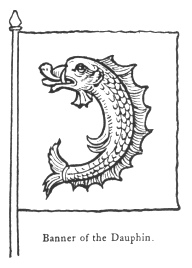
Sacred Texts Legendary Creatures Symbolism Index Previous Next
Buy this Book at Amazon.com


Fictitious and Symbolic Creatures in Art, by John Vinycomb, [1909], at sacred-texts.com
In France the bearing of the dolphin was exclusively restricted to the Dauphin or heir to the throne of the kingdom. Brydson
 |
The title "Dauphin," borne by the eldest son and heir-apparent of the kings of France under the Valois and Bourbon dynasties, originated in the Dauphins of Viennois, sovereigns of the province of Dauphiné. Guy VIII., Count of Vienne, was the first so styled. The title descended in the family till 1349, when
[paragraph continues] Humbert II., de la Tour de Pisa, sold his seigneurie, called the Dauphiné, to Philippe VI. (de Valois), on condition that the heir of France assumed the title of "Le Dauphin." The first French prince so called was Jean, who succeeded Philippe; and the last was the Duc d’Angoulême, son of Charles X., who renounced the title in 1830. In 1601, when Louis XIII. was born, there had not been a Dauphin since Francis II. (the husband of Mary, Queen of Scots)—eighty-four years. The province of Dauphiné sent a deputation to Fontainebleau, headed by the Archbishop of Vienne, to recognise the infant as their sovereign, and make him a present of an entire service of richly chased plate with various figures of dolphins, estimated at 12,000 crowns.
Grand Dauphin.—Louis, duc de Bourgogne, eldest son of Louis XIV., for whom was published the edition of the Latin classics entitled "Ad usum Delphini" (1661–1711).
Second, or Little Dauphin.—Louis, son of the Grand Dauphin (1682–1712).
Shakespeare, by an anachronism of a hundred years, introduced into King John
Mary Queen of Scots bore the title on her marriage in 1558 to the Dauphin, afterwards Francis II., and styled by her adherents: